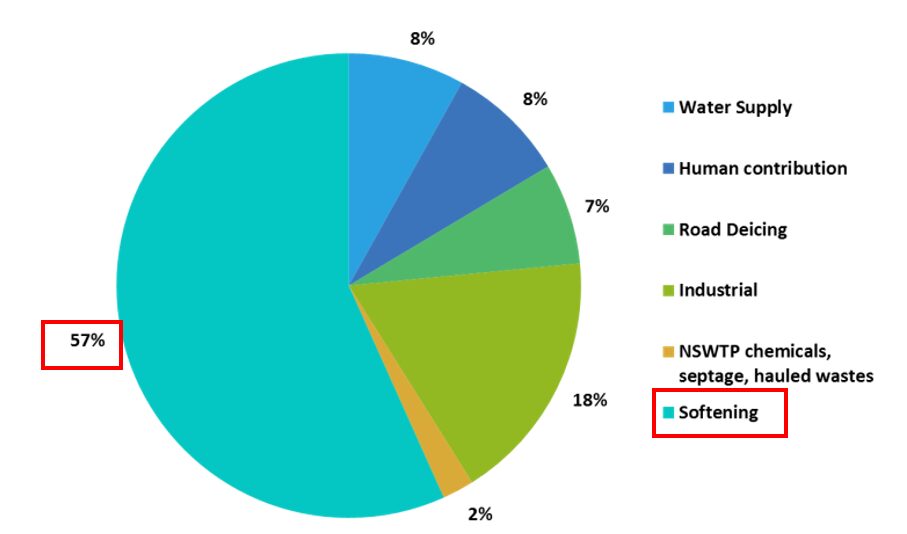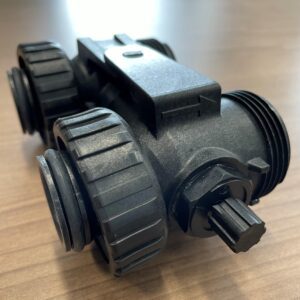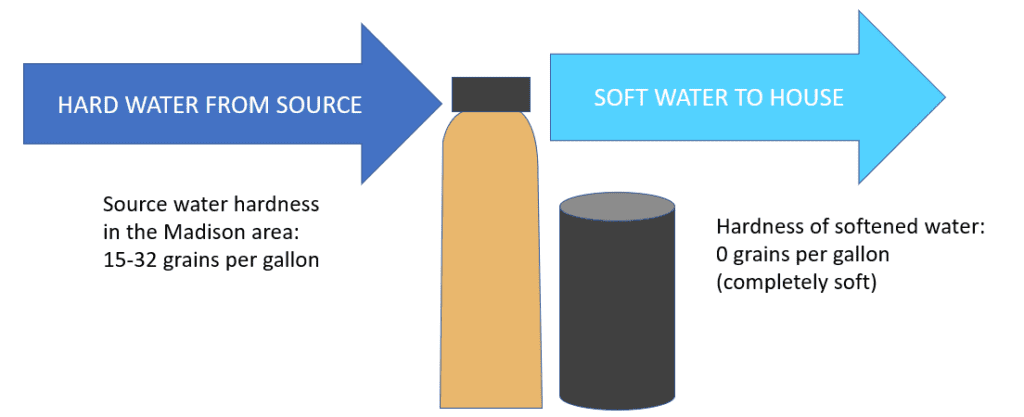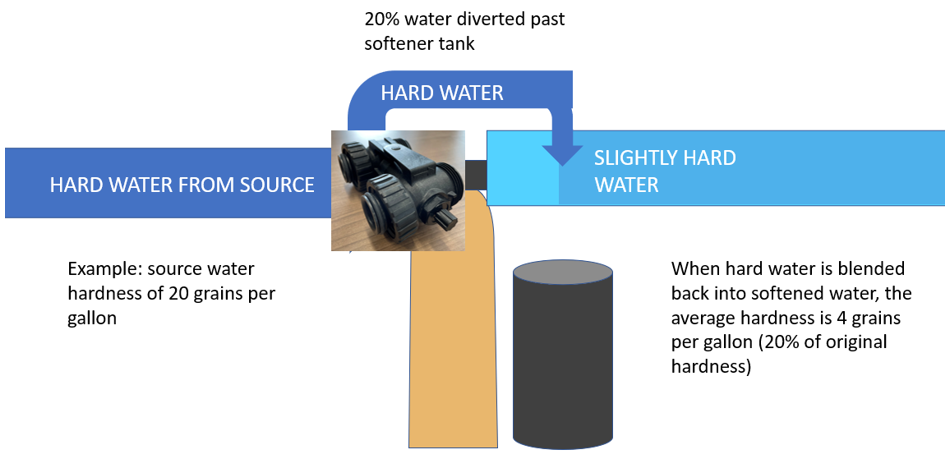Protecting water and saving salt in softeners
One way to reduce home salt use is to install a blending valve, a simple plumbing device that diverts a small portion of hard water around a water softener and mixes it back into the water that has been softened. The result is water that is mostly soft but has a small amount of hardness. By using blending valves, you reap the benefits of softened water while reducing chloride pollution in the local watershed.
MAJOR source of chloride pollution
The Nine Springs Wastewater Treatment plant receives 220,000 pounds of salt per day on average. Since our treatment plant isn’t designed to remove dissolved salt from water, there is no easy way to remove it once it is in the water. So chloride, a component of salt, passes through the treatment plant into the freshwater streams we discharge to.
Water softeners are a significant source of chloride, making up about 57% of salt contributions to the treatment plant. While other municipal activities and industrial sources contribute, reducing salt use in water softeners is the area where we all can help make the biggest impact. The less water we soften, the less salt we use.

There are different paths to reducing chloride, such as choosing more efficient water softeners or finding ways to soften less water in your home or business. Because the source water in our service area is very hard, we don’t recommend that you stop softening/conditioning your water entirely. But there is a middle ground between totally soft and totally hard water.

The less water we soften, the less salt we use
In Dane County, our natural water hardness is about 15-32 grains per gallon (gpg), which is considered very hard, so water softeners are used by most residents and business owners to prevent excessive scale buildup. Water softeners remove all hardness from water, resulting in a water hardness of 0 gpg (completely soft). However, appliances, water heaters, fixtures, dishes, hair, and clothing can handle slightly harder water without damage.
For example, Wisconsin communities that use surface water as source water, like Milwaukee and Manitowoc, have less natural hardness minerals in their water, but not zero hardness. Lake Michigan has a natural hardness of 7-8 gpg. In these areas of the state, water softeners are considered optional and not a necessity because the lower level of hardness means that scale buildup isn’t as much of an issue as it is here.
While water softeners remove all hardness from water, you can adjust the hardness of the water in your home by using a device called a blending valve on your softener. In addition to reducing your salt use, blending valves can provide the water quality you want in your home. Some people prefer slightly hard water to totally soft water, which can have a slippery feeling.
What are Blending valves?
A blending valve, sometimes called a mixing valve, is a simple, inexpensive device that is a quick plumbing add-on to a water softener. It works by diverting some, but not all, hard water around the softener and blending the hard water back into the softened water. The result is water that is mostly soft but has some hardness. The following diagrams help outline how blending valves can work.
Typical Softener Function

Blending Valve Example

Advantages of blending valves
- Reduce salt use while still protecting appliances and fixtures.
- Inexpensive part that’s quick and easy for a plumber to install.
- Blending valves are completely adjustable to a homeowner’s preference.
- Low levels of hardness have no major impact on water heater lifespan. In fact, a low level of hardness in water can actually prevent corrosion in water heaters.
For more information on how blending valves save salt, read our blog article “Soften water with less salt using blending valves.“
Blending valve water hardness settings
Blending valves can be configured to different average hardness levels (grains per gallon or gpg) based on individual preferences. The hardness level may vary a bit depending on the amount of water flowing through the valve, but should generally stay within the same range. For reference, here are levels of water hardness defined by the U.S. Geological Survey as the concentration of calcium carbonate in grains per gallon (gpg):
- 0-3.5 gpg: Soft. Water that has gone through a softener has a hardness of 0 gpg. At this level, scale impacts will be minimal, but softening to this level requires the most salt.
- 3.5-7 gpg: Moderately hard. The U.S. Department of Energy considers this level of hardness to be ideal. Blending water to this level would reduce Madison residents’ salt use by about 15-35%.
- 7-10.5 gpg: Hard. This level of hardness is comparable to the natural hardness of water bodies like Lake Michigan (7-8 gpg). Many residents of communities that use Lake Michigan water do not use water softeners.
- Above 10.5 gpg: Very hard. All water in the Madison area is very hard, ranging from 15-32 gpg depending on the well.
At any level, if you find that your home’s water is too hard or too soft for your liking, you can have a plumber adjust the blending valve to meet your preferences. Blending valves can be essentially turned off so water returns to completely softened if you so choose.
Use our blending valve and salt reduction calculator to see our much salt you can save each year!
Salt reduction calculator
* indicates required fields
Effects of Softening less water
Assume four neighboring homes each use 6,000 gallons of water per month. They all receive water from a well with 20 grains per gallon hardness.

Homes that use a high-efficiency (HE) water softener combined with a blending valve can find significant savings on salt each month.
Becoming the Norm
Thanks to partnerships and education programs with local plumbers and builders like Dave Jones and Tim O’Brien Homes, blending valves are now a standard offering on water softener upgrades and installations in new homes.









